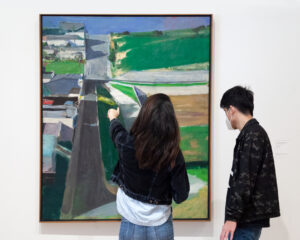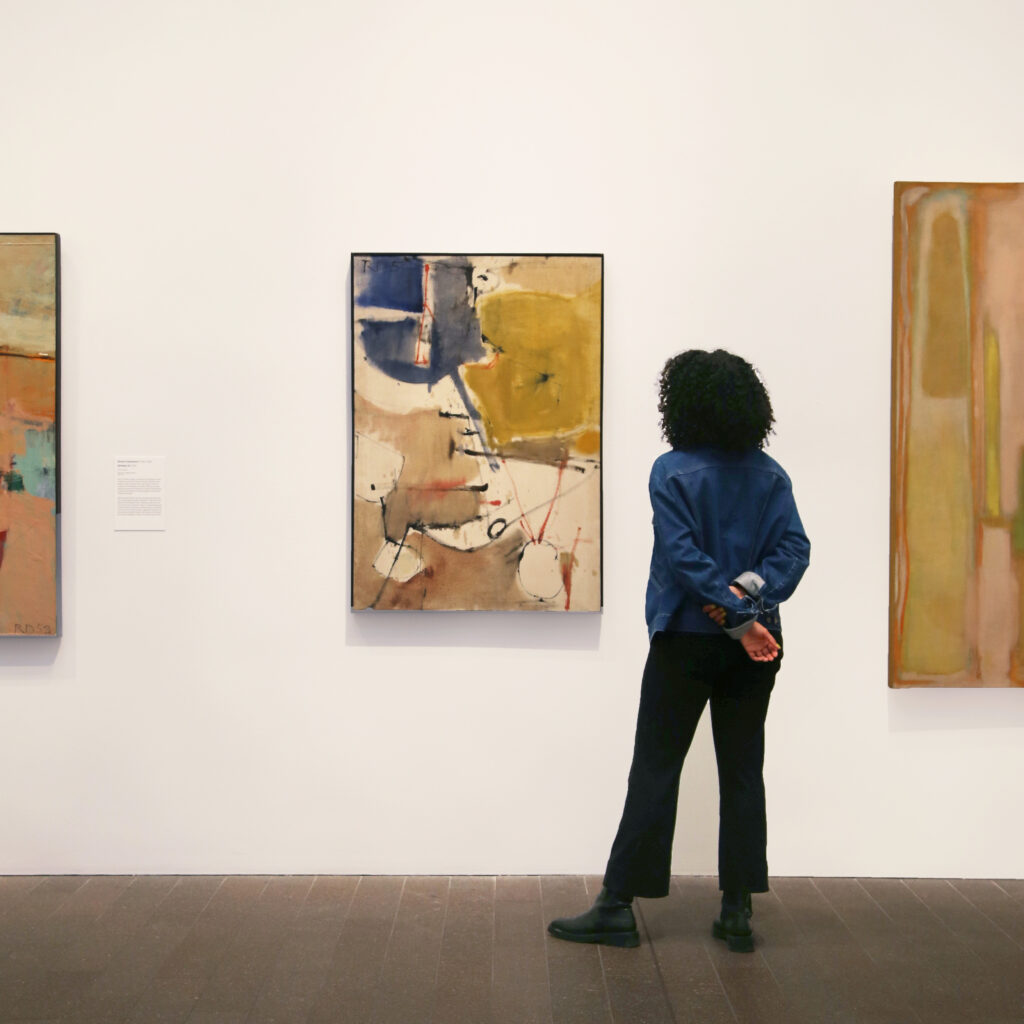Museums and art lovers celebrate #Diebenkorn100
April 22, 2022
Berkeley, CA

Aficionados, art lovers, teachers, and students coast to coast are joining #Diebenkorn100, enjoying installations, new scholarship and discoveries, and special curatorial remarks and moments in social media. Museums nationwide, from the Whitney Museum of American Art in New York City to the Fine Art Museums of San Francisco, are celebrating the artist’s beautiful, mysterious body of work by creating fresh commentary and content, from wall labels to videos to essays, for all audiences with the celebratory hashtag #Diebenkorn100.
“Anyone, anywhere is invited to join in the festivities,” said Katharine James, Head of Digital and Public Engagement at the Richard Diebenkorn Foundation. “#Diebenkorn100 really brings the celebration to many of the most beloved museums in the country and the work of the artist to everyone’s front door and screen. We wanted to create a free, inclusive, and easily accessible way to celebrate the life and art of the artist, who himself remained steadfastly curious, humble, and committed to cultivating new ideas.”
New scholarship, digital, and video
A new contribution to the study and understanding of the artist has debuted on diebenkorn.org, “Richard Diebenkorn Capturing the World for Himself, A Painter Taking Pictures” by Daisy Murray Holman, Head of Archives at the Richard Diebenkorn Foundation. The research, an expanded installment of the Foundation’s quarterly digital From the Basement series, introduces rarely seen photographs taken by Diebenkorn between 1963 and 1987, revealing an artist, as she writes, “always looking, framing” and integrating his surroundings in his painting and drawing vocabulary.
To discuss the new insights into the artist’s “private practice and the studio outside” and on the occasion of the retrospective Richard Diebenkorn: Works on Paper 1946–1992 at Van Doren Waxter, the artist’s daughter Gretchen Diebenkorn Grant and Murray Holman had an intimate conversation in the artist’s former studio in Healdsburg, speaking exclusively @VanDorenWaxter and in collaboration with the Richard @DiebenkornFoundation.
The conversation took place in front of a window depicted by the artist in a significantly scaled 1988 charcoal drawing included in the exhibition that shows with great tenderness the interior of the studio. In 1989 the artist and his wife completed the studio conversion with clerestory windows to let in the artist’s preferred northern light. Out the window the view across the vineyard is visible as is Mount Saint Helena, which Diebenkorn called “my Mont Saint-Victoire” or “la Montagne de Cézanne” after the famous peak Cézanne painted in Aix-en-Provence, France. Of the drawings in the show spanning every period in the artist’s career, and the voluminous amounts of work on paper produced by the artist in his lifetime, Diebenkorn Grant commented “that through all the styles, there is the sense of this person, this soul.” And remarking on the rarely seen photographs embedded in the new essay, especially the artist’s travel photographs—a 1978 photograph taken in France, a 1979 snapshot from a trip to Venezuela—Diebenkorn Grant confessed during the Instagram Live that she “never saw” many of these “private photographs, somehow…they were not shared.” “But,” she added, “they are so him. They are so the way he sees.”
Debuting this fall, the Foundation will release a series of newly commissioned #Diebenkorn100 essays in miniature @DiebenkornFoundation by a diverse group of young contemporary visual critics. The first essay in the tripartite program will be written by prose-poet, essayist, and art writer Charity Coleman, whose work has appeared in Artforum, BOMB, and elsewhere. The critics have been invited to write on any work, series, or period in the artist’s career and with full access to the archives of the Foundation.
And special to #Diebenkorn100, the Foundation recently invited viewers into the artist’s print production. Released exclusively online, a new video features excerpts of interviews conducted by Karin Breuer, Curator in Charge of the Achenbach Foundation for Graphic Arts at the Fine Arts Museums of San Francisco, with printers who knew and worked with Richard Diebenkorn, from Crown Point Press beginning in the 1960s to Tamarind Lithography Workshop in the same decade to Gemini G.E.L. in the 1980s. Introduced with a warm #Diebenkorn100 welcome by Andrea Liguori, Editor of Richard Diebenkorn: The Catalogue Raisonné of Prints and Managing Director at the Richard Diebenkorn Foundation, and debuted simultaneously on @LegionofHonor and @DiebenkornFoundation, the videos highlight Diebenkorn’s repeated and ongoing return to printmaking as a medium. Eight episodes will be released on diebenkorn.org in 2023 in anticipation of the forthcoming full-color, lavishly illustrated volumes (Yale University Press, 2024).
Coast to coast installations
In the Northeast and Southeast, participating institutions include the Albright-Knox Art Gallery, the Morgan Library & Museum, the New Orleans Museum of Art, the North Carolina Museum of Art, the Norton Museum of Art, the Orlando Museum of Art, the Phillips Collection, the Virginia Museum of Fine Arts, the Whitney Museum of American Art, and the Yale Art Gallery.
At the Yale Art Gallery, Ocean Park #24 (1969) is on view and a special #Diebenkorn100 post is planned @YaleArtGallery. Commenting on the canvas, Susan Landauer, writing in “Significant Space in Diebenkorn’s Ocean Parks,” for the fully illustrated exhibition catalogue that accompanied the traveling Richard Diebenkorn: The Ocean Park Series (2011–2012) organized by Sarah Bancroft, a preeminent authority on the art of Richard Diebenkorn and President of the Richard Diebenkorn Foundation, asserts that the “Mondrian-like line” creates “stability like a pedestal holding together the whites…while at the same time creating dimensional tension by slicing through the chromatically differing fields of blue.”

In the Midwest, participating institutions include the Art Institute of Chicago, the Des Moines Art Center, the Milwaukee Art Museum, and the Nelson-Atkins Museum of Art. Examples from the artist’s epic Ocean Park cycle are on view at the Des Moines Art Center and the Milwaukee Art Museum—the chalky hued Ocean Park #70 (1974) and the expansive, highly activated Ocean Park #16 (1968) respectively—and at the Nelson-Atkins, the artist’s Interior with a Book (1959) is on display. The 1959 oil on canvas was made the same year that a young Richard Diebenkorn was included in New Images of Man, an exhibition of paintings and sculptures by more than 20 American and European artists organized by Peter Selz, Curator of Painting and Sculpture at the Museum of Modern Art in New York City, which included work by Francis Bacon, Willen de Kooning, Alberto Giacometti, and Jackson Pollock.
In the West and Texas, participating institutions include the Dallas Museum of Art; the Museum of Contemporary Art, Los Angeles; the Norton Simon Museum, which opens Alternate Realities, an exhibition focusing on four groundbreaking painters who were active in Los Angeles or the Bay Area in the 1950s and 1960s: John Altoon, Richard Diebenkorn, Frank Lobdell, and Emerson Woelffer from May 15 in Pasadena; and the Orange County Museum of Art. The Foundation is especially delighted that in the San Francisco Bay Area, every major institution has work on view in their galleries and is participating online, including the Anderson Collection at Stanford University, the Cantor Arts Center, the Crocker Art Museum, the Fine Arts Museums of San Francisco, the Oakland Museum of California, the San Francisco Art Institute, the San Francisco Museum of Modern Art, the San José Museum of Art, and the University of California, Berkeley Art Museum and Pacific Film Archive.

At the San Francisco Museum of Modern Art, the iconic Cityscape #1 (1963) is on view and the 1955 oil on canvas Still Life with Orange Peel (1955) has been specially installed on the occasion of #Diebenkorn100. And in an intimate response to Murray Holman’s new research on diebenkorn.org on photographs that appear to be direct studies for the artist’s major paintings, such as Cityscape #1, Janet Bishop, Chief Curator of Painting and Sculpture, has written a special reflection @SFMOMA, saying that, “Some structures remain and there are many more. Cars still park parallel on the street’s west side and perpendicular on the east. The trees in the foreground are much larger now. From the shadows cast from the houses into the street, it must have been afternoon when Diebenkorn took his picture, as it was when I took mine.”
At the Fine Arts Museums of San Francisco, where the sweeping, interlocking Seawall (1957) is currently on view at the de Young Museum along with a large-scale, geometrically grounded 1979 oil and charcoal and a 1953 Abstract Expressionist canvas, the museums are showcasing the works throughout April in stories and posts @deYoungMuseum with a fresh interpretation of the artist by Timothy Anglin Burgard, Distinguished Senior Curator and Curator-in-Charge of American Art, and a penetrating essay in mico by Emma Acker, Associate Curator of American Art, about Seawall, remarking that “with the saturated jewel tones of his palette, he conveyed the freshness and vibrancy of a clear day in the Bay Area as though he were painting en plein air.”
The Anderson Collection at Stanford University has added to a group of oil paintings currently on view—Berkeley #26 (1954), made a year prior to Diebenkorn’s decisive shift from abstraction to representation; Girl on the Beach (1957); and Ocean Park #60 (1973)—with a special loan of four Ocean Park drawings and a 1984 Leo Holub portrait of the artist in his Ocean Park studio by the Andersons’ daughter, Mary Patricia “Putter” Pence. The Foundation also added to the installation by loaning a work made during the artist’s time at Stanford (he was awarded a degree in 1949), Untitled #32 (Sausalito) (1949). Director Jason Linetzky has invited students to produce specially created interpretive texts, the first of which will be featured on @DiebenkornFoundation and @Anderson.Collection.Stanford.

And at the Crocker in Sacramento, the museum is celebrating #Diebenkorn100 with a public unveiling of the artist’s #2 (Sausalito) (1949), a new acquisition, with remarks by Associate Director and Chief Curator Scott A. Shields. The canvas was included in the traveling Richard Diebenkorn: Beginnings, 1942–1955 organized by the Richard Diebenkorn Foundation in conjunction with the Crocker, and was the first to solely examine the work Diebenkorn made prior to his switch to figuration, focusing on the artist’s stylistic and technical origins in oil, watercolor, gouache, ink, crayon, and collage. Beginnings featured 100 works from the collection of the Richard Diebenkorn Foundation, most of which had never before been publicly exhibited, ranging from World War II drawings and watercolors of soldiers and military bases, to abstractions that unite the forms of Surrealism and the fractured planes of Cubism, to gestural works on paper. Shields also prepared a lively essay in micro @CrockerArt on the artist’s Flowers (1957).
*
If you are an institution and would like to participate in #Diebenkorn100, please write to Katharine James, Head of Digital and Public Engagement at katharine@diebenkorn.org.
If you are a member of the press and would like more information, please write to Brent Foster Jones, Public Relations for the Richard Diebenkorn Foundation at press@diebenkorn.org.